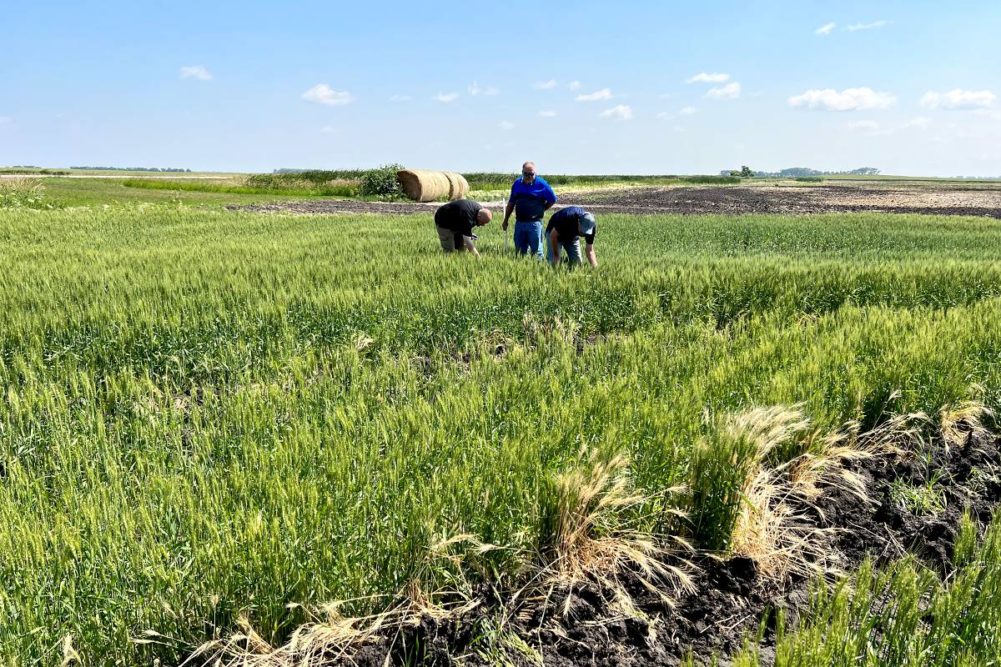MANDAN, SD. — Across the six cropping districts that comprise the southern half of North Dakota, the 2022 hard red spring wheat crop is overall in good shape. Fields are mostly about four to six weeks out from harvest, behind the typical pace following a weather-stretched planting window. Disease and pest pressures are minimal in most areas, although grasshoppers’ destructive appetites are a growing concern.
Those were the findings of a 50-strong group of wheat scouts composed of growers, commodity traders, millers, bakers, ingredient manufacturers, government analysts, academicians and members of the media taking part in the 2022 Hard Spring and Durum Wheat Quality Tour.
The first full day of the ongoing tour saw scouts depart Fargo, ND, early Tuesday in rented SUVs and minivans, taking one of seven pre-arranged, color-coded routes headed west or north into the interior of the top US production state for spring wheat. A traditional eighth route, purple, was abandoned this year. Tour officials explained that the route, southbound from Fargo into the northeastern counties of South Dakota and westbound past Eureka, SD, before jutting back into North Dakota, did not feature any spring wheat fields this year.
Along the red route, a team of four traveled west to Casselton, north though the towns of Arthur and Hunter before zigging west through Mayville-Porter and zagging back to the south slightly and west to Cooperstown. That group’s first measurement, taken near Arthur in Cass County, ultimately was their highest estimated yield of the day at 63.4 bus an acre. By mid-morning the group also had measured a field in poor condition featuring spotty stands, short wheat and dry, sandy soil. That stop was the team’s lowest yield estimate of the day, 15.68 bus per acre, taken west of Cooperstown in Griggs County.
Both of those measurements proved to be outliers. Over the course of 14 fields stops, the team mostly calculated yields in the mid-40-bus-an-acre range. Spotty stands were not the norm, but were noted in several instances in lower ground that likely was very wet during planting. Numerous fields had rows of wheat surrounding empty low-lying areas, some of which still had standing water.
Visible from the state roads, gravel backroads and interstate were some fields or portions of fields that appeared to be unseeded. Tour veterans speculated those were “prevent plant” acres in which farmers likely received insurance money after an extremely wet northern Plains spring muddied fields to a degree seeds could not be drilled before it was too late vis-à-vis the development time needed to bring the plants to maturity by harvest in August or September. However, scouts had no way to determine what crop had been intended.
In measured fields across the Day 1 area of concentration, scouts saw instances of flag leaf stripe rust, fusarium head blight and ergot. But none of those pressures were widespread or even a dominant characteristic of the fields in which they were found. Some routes saw an elevated presence of grasshoppers, which the North Dakota Wheat Commission has noted in the most recent editions of its weekly wheat update. A central North Dakota farmer said they were prevalent and rather than munching on the wheat heads and berries instead preferred to chew through the stalk just below the head. The farmer said the insect intrusion was extremely hard to control after the hoppers reached maturity and began to jump around from plant to plant. The sheer number of grasshoppers present in his fields was a concern for the next crop year as well, he said.
Scouts gathered for a meeting Tuesday in Mandan before departing to Fort Abraham Lincoln for dinner and sightseeing. During the meeting, Wheat Quality Council officials gathered yield estimates recorded by teams at every field stop from Fargo to Mandan and calculated an average yield estimate. Based on proprietary formula determined by the USDA in conjunction with the observed row spacing width, head and spikelet counts measure during 100 fields stops, the Day 1 average bus per acre estimate for hard red spring wheat in 2022 was 48.9 bus per acre, compared with 29.5 bus per acre as the first day average in 2021 during a harsh drought.
The Day 1 average durum bus per acre calculated from four durum fields measured was 26.5 bus per acre.
The tour continues Wednesday as scouts plan to follow seven routes from Mandan to Devil’s Lake, ND.





